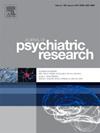Does trait impulsivity differentiate impulsive from non-impulsive suicide attempts?
IF 3.2
2区 医学
Q1 PSYCHIATRY
引用次数: 0
Abstract
Background
Suicide poses a major public health concern, with impulsive suicide and suicide attempts representing a particularly difficult subset of cases for effective suicide prevention. The relationship between impulsive suicidal behavior (ISB) and impulsivity as a trait, which can be assessed by specific questionnaires, is still unclear. This study, therefore aimed to investigate this association by comparing the degree of trait impulsivity as well as clinical and demographic variables in individuals with ISB to those with non-impulsive suicidal behavior (NISB).
Methods
We included 130 adult inpatients admitted to a psychiatric ward of three psychiatric hospitals in Thuringia, Germany after a suicide attempt. Three distinct criteria were applied to define ISB, considering time- and planning-related aspects, as well as prior suicidal attempts using the Suicide Intent Scale and a structured clinical interview. Trait impulsivity was assessed using the Urgency, Premeditation, Perseverance, Sensation- Seeking (UPPS) Impulsive Behavior Scale.
Results
No significant differences in the four UPPS impulsivity components controlling for multiple clinical and suicide specific variables were observed between the ISB and NISB groups across all three criteria as well as in clinical and demographic variables.
Conclusion
These findings underscore the complexity of the relationship between ISB and the various facets of impulsivity. They further highlight the need to improve standardized assessment methods to better identify individuals at risk for ISB and to develop effective intervention strategies to prevent such individuals from engaging in suicidal behavior during acute crises.
性格冲动性是否能区分冲动性和非冲动性自杀企图?
自杀是一个主要的公共卫生问题,冲动自杀和自杀未遂是有效预防自杀的一个特别困难的案例。冲动性自杀行为与冲动性作为一种可以通过具体问卷进行评估的特征之间的关系尚不清楚。因此,本研究旨在通过比较ISB个体与非冲动性自杀行为(NISB)个体的特质冲动性程度以及临床和人口学变量来研究这种关联。方法本研究纳入德国图林根州三家精神病院精神病病房收治的130名自杀未遂的成年住院患者。三个不同的标准被应用于定义ISB,考虑时间和计划相关方面,以及使用自杀意图量表和结构化临床访谈的先前自杀企图。特质性冲动采用紧迫性、预谋、毅力、感觉寻求(UPPS)冲动行为量表进行评估。结果ISB组和NISB组在控制多个临床和自杀特定变量的四个UPPS冲动成分在所有三个标准以及临床和人口统计学变量上均无显著差异。结论这些发现强调了ISB与冲动性各方面之间关系的复杂性。他们进一步强调需要改进标准化的评估方法,以更好地识别有ISB风险的个人,并制定有效的干预战略,以防止这些个人在急性危机期间从事自杀行为。
本文章由计算机程序翻译,如有差异,请以英文原文为准。
求助全文
约1分钟内获得全文
求助全文
来源期刊

Journal of psychiatric research
医学-精神病学
CiteScore
7.30
自引率
2.10%
发文量
622
审稿时长
130 days
期刊介绍:
Founded in 1961 to report on the latest work in psychiatry and cognate disciplines, the Journal of Psychiatric Research is dedicated to innovative and timely studies of four important areas of research:
(1) clinical studies of all disciplines relating to psychiatric illness, as well as normal human behaviour, including biochemical, physiological, genetic, environmental, social, psychological and epidemiological factors;
(2) basic studies pertaining to psychiatry in such fields as neuropsychopharmacology, neuroendocrinology, electrophysiology, genetics, experimental psychology and epidemiology;
(3) the growing application of clinical laboratory techniques in psychiatry, including imagery and spectroscopy of the brain, molecular biology and computer sciences;
 求助内容:
求助内容: 应助结果提醒方式:
应助结果提醒方式:


